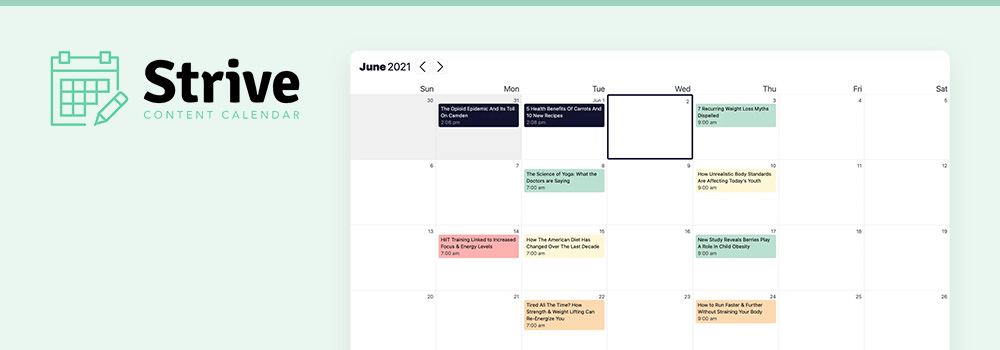How to Create & Commit to a Consistent Blogging Schedule

Once you’ve decided to blog regularly, it’s tempting to publish a post whenever you finish writing a post. However, this really isn’t the best long-term strategy. We’ll discuss the “why” of that in this post. But we’ll also be discussing a few factors that affect blog posting schedules, including the frequency of posts you should commit to, the best tools to use for committing to a blogging schedule, as well as a few ways to mitigate potential problems that should arise.
Let’s get straight into it.
Why a Blog Publishing Schedule is Important
Though it’s tempting to “wing it” when publishing blog posts, having a schedule can really help you maintain the commitment. Otherwise, you’ll just view your blog as an extra or a non-essential activity. A blog schedule also helps you to plan out your content ahead of time so you’ll be able to prepare timely or seasonally-appropriate posts as well.
How Frequently Should I Publish Blog Posts?
How often you post will depend greatly on your industry and what sort of content you want to share. For instance, if you run a news-related blog, then daily posts or even multiple posts per day would be expected. However, if you tend to focus more on in-depth researched or reported pieces, once a week or even once every other week might be enough.
A good way to figure out the ideal schedule for your blog is to see what your competitors are doing. How often do they post? What types of posts do they write? Often, this cursory glance will offer enough information to come up with a blog schedule that works for you.
As far as official recommendations go, HubSpot suggests small blogs post 3-4 times per week to increase organic traffic or 1-2 times per week if you want to build brand awareness. Your mileage may vary, of course.
Now, there is one other factor that comes into play when determining your post frequency that has nothing to do with what everybody else is doing. Rather, it has to do with what you can personally handle. Or, what your team can handle. If you don’t have the staffing to handle the addition of more than one blog post per week, you need to either cut back your expectations or hire a writer to assist you.
Once you have the post frequency settled in your mind, determine which days of the week you want your posts to go live. YOu can adjust this over time, of course, especially if traffic data suggests a change would be fruitful. But to begin, settle on the day(s) of the week and time you want to publish.
5+ Tools for a Consistent Post Schedule
While you can schedule blog posts directly in WordPress with ease, you may wish to have more control over creating a publishing schedule for your blog. Several tools and plugins can provide these features. Most of what follows are plugin suggestions that add tools to WordPress for planning, coordinating, and scheduling blog posts.
1. Strive Content Calendar

First on our list is Strive. This all in one editorial manager includes everything you need to stay on top of your blog. First is a helpful content calendar, where you can plan out your post schedule. The calendar includes features for drag & drop post scheduling (or rescheduling), a well as quick calendar additions thanks to the one click draft inserter. There are also color coded post statuses, so you can see at a glance where in the writing process each of your posts are.
Strive also includes support for post checklists to ensure all of your content complete, post revision planning to make refreshing old posts a part of your regular schedule, and a Pipeline feature to track all of your current posts in progress (from idea to publish).
2. Editorial Calendar

Though it’s easy enough to schedule posts for publication within WordPress, it’s not always to see all what you have scheduled for the future. That’s where the Editorial Calendar plugin comes into play. It offers a convenient way to view all of your scheduled posts via a calendar view. Within this view, you can drag-and-drop posts around, edit them right within the calendar, and click through to make more edits.
This makes it incredibly easy to change post dates, change post titles, add posts to the schedule, and more. It also allows you to see where your posts are in the publication chain (draft, pending, etc).
3. PublishPress

Another option for configuring your blog post schedule is to use the plugin, PublishPress. This plugin allows you to create an editorial calendar, set up custom statuses for your posts, send out notifications regarding content updates, and more. This is a great choice if you plan on featuring more than one author on your blog. It streamlines the collaborative process and allows you to assign edits or updates to posts by adding these as post statuses instead of having to send out multiple emails.
It’s a popular choice for online publications.
4. WP Scheduled Posts

WP Scheduled Posts is still another way to make managing your posting schedule a bit easier. This plugin includes a variety of tools that allow you to schedule blog posts in advance for publication, allowing you more freedom from the desk, so to speak.
One of its primary features include a Schedule Calendar, where you can manage all of your content visually. With this calendar view, you can add posts to the queue and set them to publish on specific days. This plugin also has a dashboard widget for easier post scheduling from the typical admin view in WordPress. You can drag-and-drop posts around on the calendar to reconfigure your blog schedule. You can even manage multiple authors this way.
5. CoSchedule

Next is CoSchedule, a marketing tool that allows you to manage multiple aspects of blog post publication from your WordPress dashboard. For starters, it has a marketing calendar that allows you to view all of your projects at once, including the workflow for each post. This includes all related social media posts, email blasts, events, and more.
It also has a content organizer for managing all aspects of writing posts. You can set custom statuses for your post workflow and view it all via an integrated Kanban board. It has a social organizer, too, where you can create full campaigns for all your social profiles. This way social posts can go out as soon as your new blog posts go live. It has a “best time” scheduling feature and a “ReQueue” feature to further automate social sharing as well. CoSchedule is a premium plugin but you can try it out using their 14-day free trial.
6. Publish to Schedule

Last is Publish to Schedule, another WordPress plugin that can make it easier to publish content on your blog. Once this plugin is installed, you just have to set it up once. Then your posts will be scheduled for publishing automatically. All you have to do is click Publish when you’re done writing your post. But instead of being published right away, it’ll go into a publication queue.
This queue is determined by the settings you configure at plugin installation. During the setup process, you have to set the days of the week and times you want posts to go live. It reminds me a lot of social scheduling tool, Buffer, in that way: just set your blogging schedule, add posts to your queue, and walk away.
Blogging Schedule Troubleshooting: How to Keep Up the Commitment
It’s easy to dive into blogging with gusto. It’s much harder to keep up the momentum, however. That’s why it’s a good idea to have a few solutions in your back pocket when things get tough.
1. I can’t think of what to write about!
Writer’s block is no fun, especially if you have a schedule to keep. Thankfully, there is a way to prevent it from slowing you down. You can gain inspiration by reading other blogs and brainstorming, of course. But your best bet is to simply plan ahead. An ounce of prevention is worth a pound of cure, and all that. Always have 4-5 ideas jotted down so you have something to spark your creativity, even if you’re not feeling it.
2. I don’t have time to write anything this week.
Being pressed for time is a struggle, especially when you have a lot of projects in the works. Prevent the time crunch by, once again, planning ahead. Fill your blog post queue so that you’re scheduling posts at least two weeks ahead of time. That way, if you have an off day, you have time to make it up.
3. I’m overwhelmed! There are too many things to keep track of when publishing.
There really is a lot to keep track of when publishing content. However, a solid workflow will save you every time. Whether you rely on an integrated plugin like those listed above or you use an external project management tool like Trello or Asana, using one of these tools can help you keep your post drafts, their publish date, related social media posts, email newsletter copy, and other applicable marketing materials all in one place. Spending a little time organizing everything upfront can alleviate a lot of the feelings of overwhelm in the long run.
Your Blog Post Schedule Can Expand Your Audience
The fact of the matter is that publishing blog posts regularly is good for SEO. It can drive organic traffic to your site. However, it’s also valuable for increasing people’s awareness of your brand and what it is you do as a company/influencer. Because of this reason, no matter how difficult it is to commit to a blog posting schedule, the payoff is well-worth the effort. Every time.


